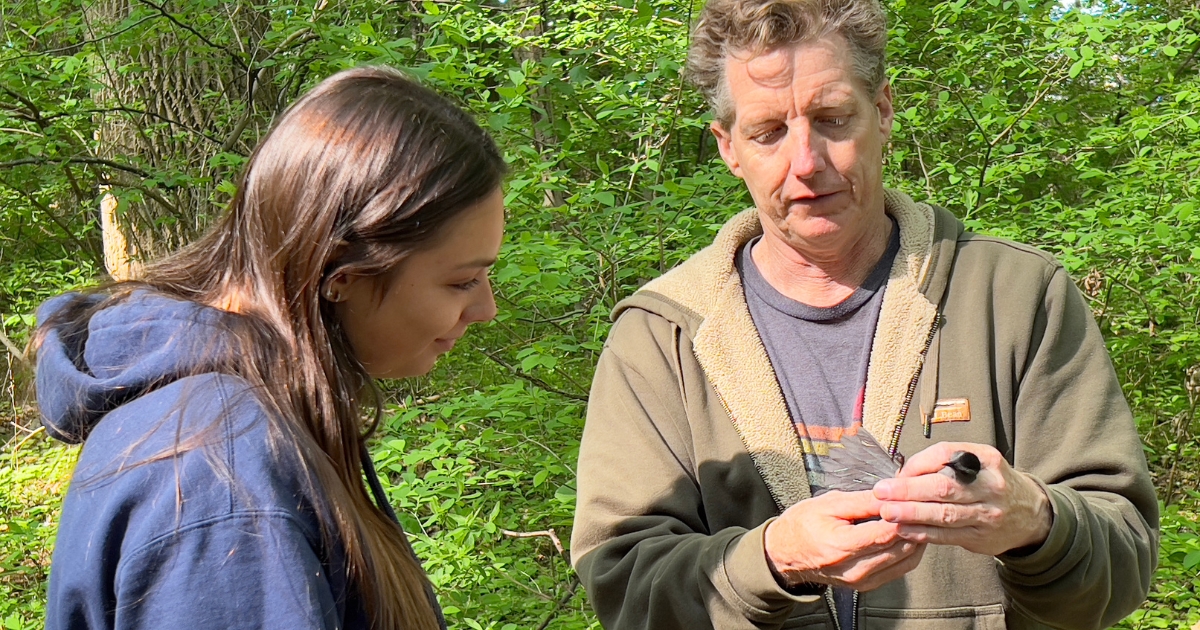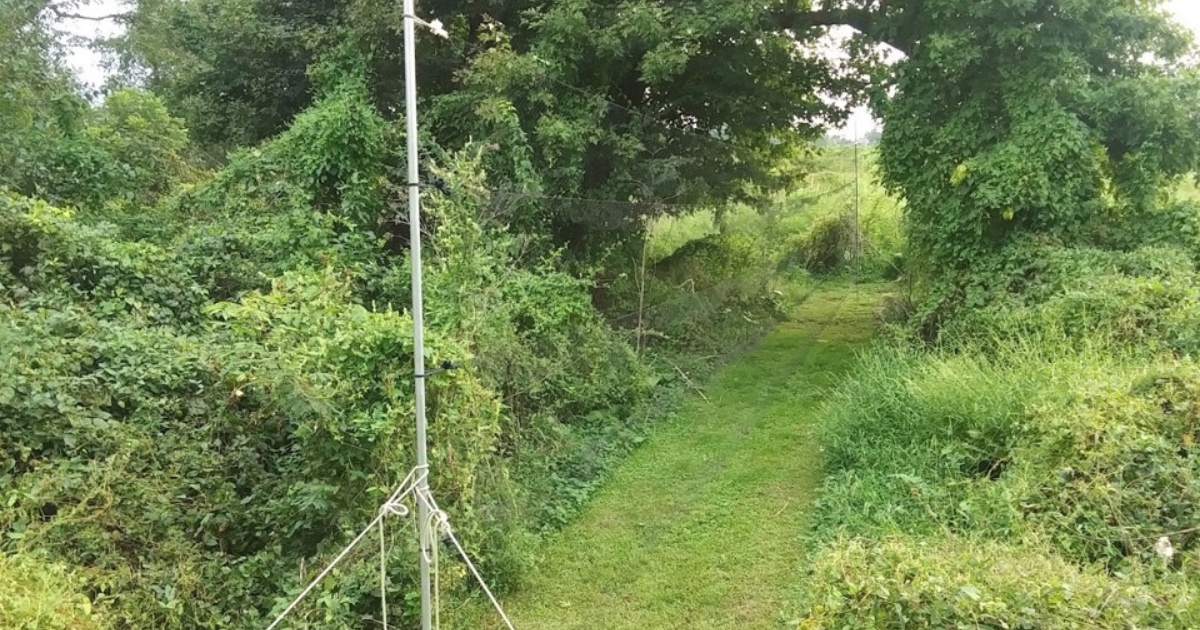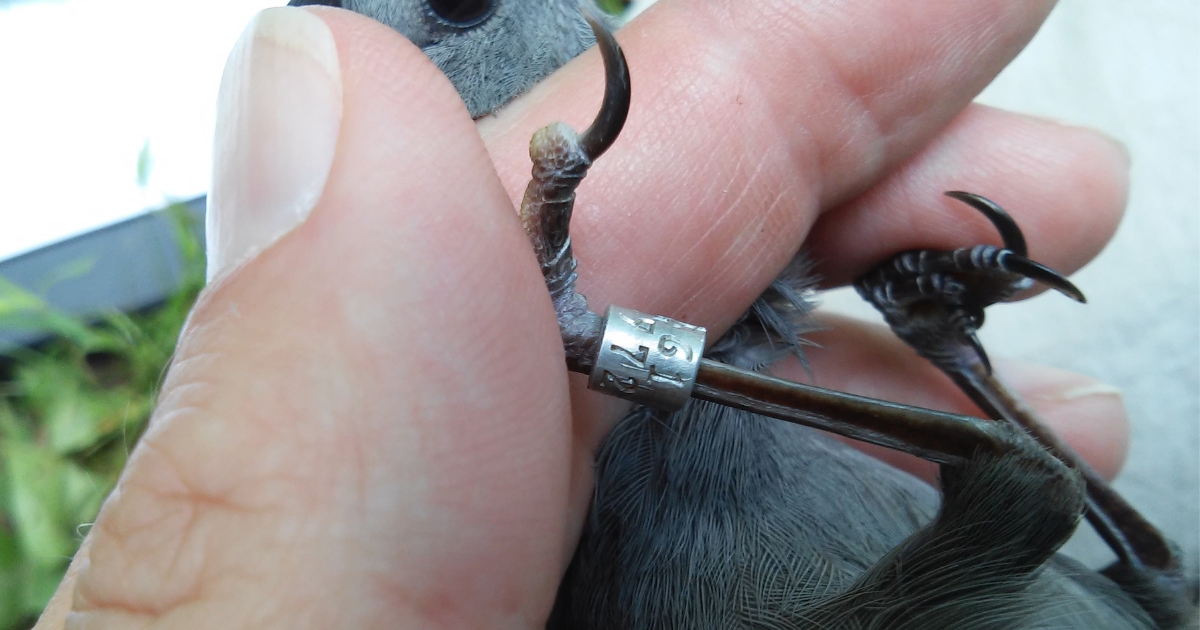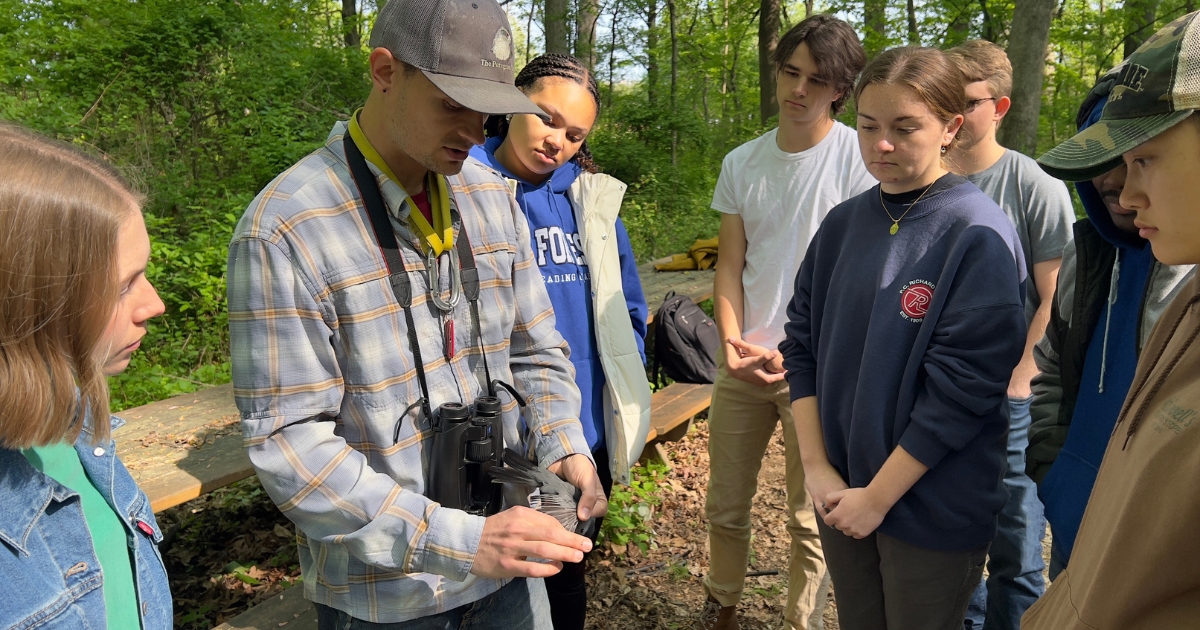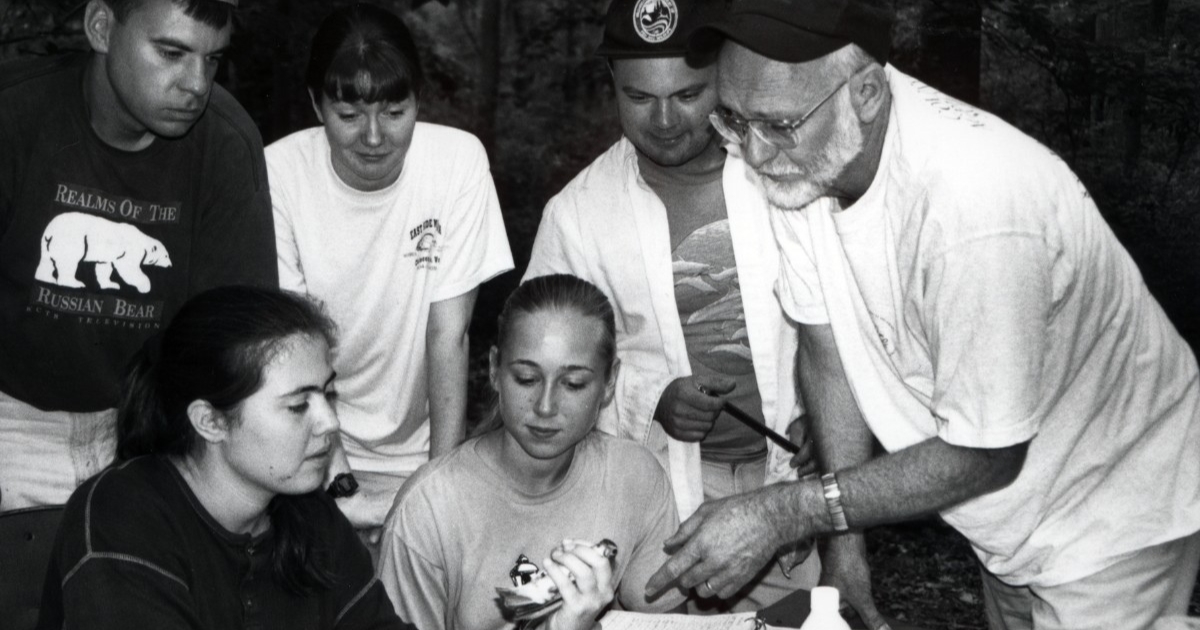
Roland Roth Ecology Woods
Roland Roth Ecology Woods is a 35-acre urban forest on CANR’s Newark campus. The tranquil woodland offers opportunities to study wildlife, ecosystems, and the effects of habitat fragmentation just steps from the classroom. The area is a remnant of a larger woodland and has been isolated from other forests since 1937. With sections of woodland more than 150 years old, this forest fragment offers a unique opportunity to contribute to and learn from long-term data related to the challenges faced by contemporary forests and ecosystems.
For the past 60 years, Blue Hens have gathered data, performed critical research and made inspiring observations in Ecology Woods. Students and faculty from the College of Agriculture and Natural Resources have researched birds, reptiles, amphibians, insects and plant life in Ecology Woods. In 1972, Ecology Woods became an active research site for faculty emeritus Dr. Roland Roth’s study of the breeding ecology of the wood thrush, a migratory songbird that returns to this site every April.
I think having land and not ruining it is the most beautiful art that anybody could ever want.
History
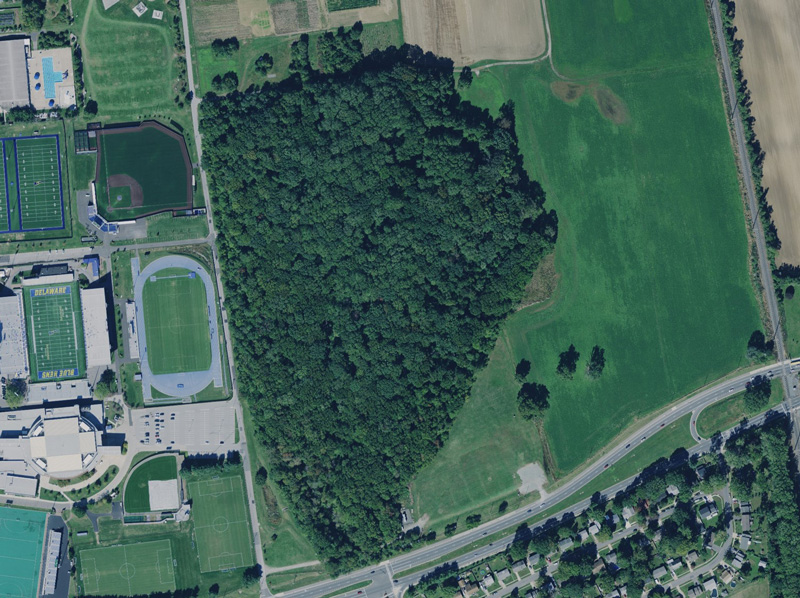
Ecology Woods is located on the southern edge of UD’s Newark Farm, adjacent to Route 4 and the UD Athletics Complex. The area has provided a unique site for ecological research, conservation, and student learning since the 1960s. The Department of Entomology and Applied Ecology’s (now the Department of Entomology and Wildlife Ecology) 1965 research report, titled “Wildland Ecology and Urban Impact,” helped to pave the way for conserving Ecology Woods. The report included a survey of the flora and fauna of the woods along with related research and cited a growing “national public concern of the quality of appearance and rate of disappearance of our natural landscape.”
That same year the woods were preserved as a teaching and research area through the efforts of E. Paul Catts of the Department of Entomology and Applied Ecology, with the support of Dale Bray, department chair, Robert Jones, assistant professor, and Jerry Longcore, research associate. Roland Roth assumed oversight of Ecology Woods when he joined the faculty in July 1971.
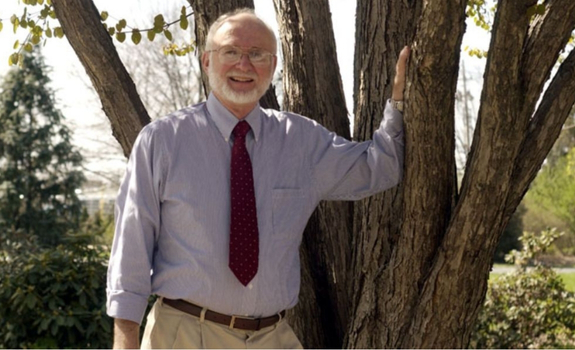
Throughout his tenure, Roth worked tirelessly to preserve Ecology Woods. In the spring of 1975, an eight-foot chain-link fence topped by barbed wire was installed around the woods to protect the ecosystem from trespassers. In the late 1970s, the widening of nearby Route 4 threatened to shrink Ecology Woods’ footprint. A citizen committee that included Roth and Catts successfully fended off the threat.
Today, Ecology Woods remains a pristine living laboratory. Researchers continue to add to decades of collected data, and students have the unique opportunity to study an ecosystem over time.
Remembering Dr. Roland Roth
On September 18, 2025, the College of Agriculture and Natural Resources hosted a special event to honor the generous supporters of the Roland Roth Ecology Woods Fund, which supports the ongoing teaching and research efforts in this 35-acre gem on the college's grounds.
Alumni, colleagues, and friends who benefited from Dr. Roth's passion for conservation came together with the Roth family to honor his legacy. The program featured keynote remarks from Dr. Doug Tallamy, a longtime colleague of Roland Roth, followed by a reception and visits to the newly named Roland R. Roth Ecology Woods.
Please enjoy these photos and a recording of the program.
Current courses connected to Roland Roth Ecology Woods
In their first term, wildlife ecology and conservation students learn basic field skills and exposure to the careers, opportunities, and expectations for an ecologist.
Students learn the basic principles of ecology. In this course, Blue Hen scholars study ecological and sociological problems and solutions in the conservation of biodiversity.
This course focuses on Eastern native United States and broad-leaf and coniferous plants used in the landscape. Topics include native habitat, ornamental features, potential pest problems and taxonomy using cut samples as well as landscape specimens.
Through field trips, dissection and experiments, students study insect structure, physiology, behavior, taxonomy, evolution and ecology. Insect collection (with identification to orders) is required.
Wildlife ecology and conservation students gain hands-on experience in techniques and fieldwork critical for their future wildlife careers, including navigation, animal capture and handling and vegetation sampling. Faculty overview the variety of careers open to ecologists.
Students learn sampling techniques for insect survey or biodiversity studies while gaining field experience. The course includes instruction in research design, data preparation, analysis and interpretation.
This course is designed as a conceptual and practical introduction to medical entomology, which is the study of arthropods of human medical importance. Students learn about arthropods of medical importance in addition to exploring questions and ideas around the interaction between humans and their pests. Through assignments, field trips, and class activities, students will, in addition to becoming medical entomology researchers, sharpen their abilities to extract key information from scientific papers and hone their skills in science communication.
An introduction to basic principles and methods of wildlife habitat management in forests, grasslands, wetlands, agriculture, and urban areas. Labs include field trips to visit various habitats and learn about habitat management directly from local wildlife professionals.
Ornithology students study the natural history of birds and learn to identify taxa by sight and sound. The class consists of lectures, labs and frequent field trips and covers avian biology: diversity, evolution, form and function, behavior and communication, reproduction and development, and conservation.
Students learn the biology, physiology and systematics of aquatic insects with emphasis on the fauna of North America. Students visit local streams to identify insects at the family level, understand water quality and the importance of insects as bio-indicators.
Stories featuring Roland Roth Ecology Woods
-
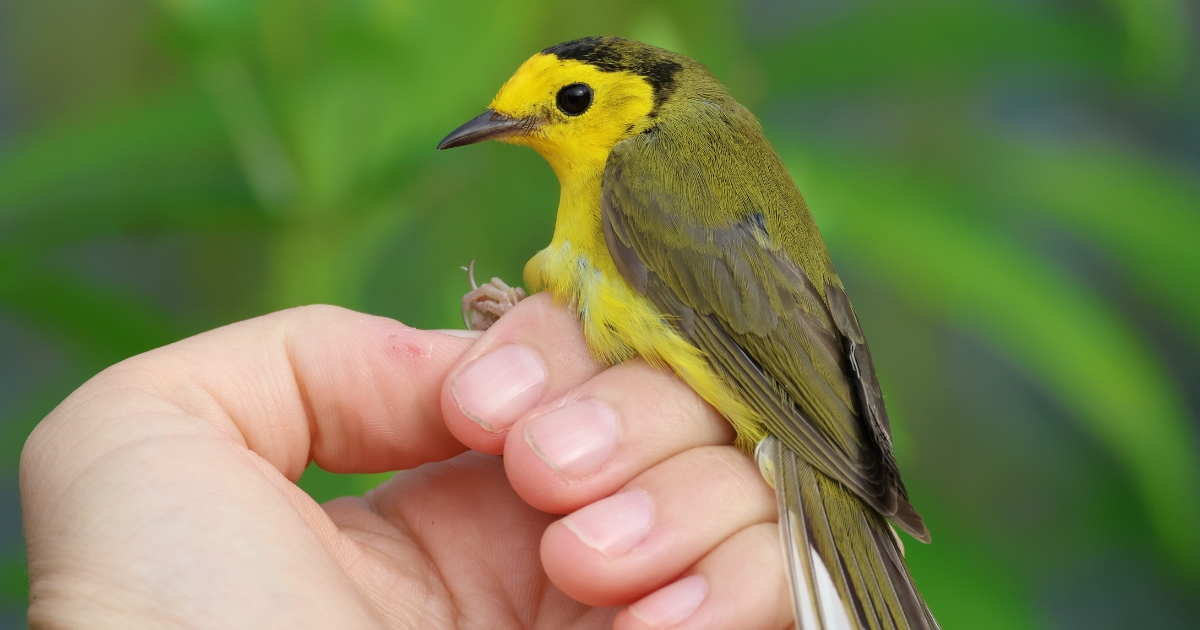
A living legacy: UD's Ecology Woods named in honor of late professor
October 17, 2025 | Written by Josh Shannon | Newark PostThe 35-acre forest known as UD’s Ecology Woods was named this year in honor of Roland Roth, the late UD professor who utilized the woods as an educational resource. The Roland Roth Ecology Woods, an untouched lush forest gem in South Campus, has been used in teaching since 1965, a place for students to learn about field techniques, animal research, and a place to practice trapping birds and mammals to study. -
To The Bat Cave
December 03, 2024 | Written by Molly SchaferRebekah Kading, associate professor at Colorado State University, studies vector-borne pathogens and emerging arboviruses. The UD alumna says her teaching methodology is influenced by the months she spent in UD’s Ecology Woods, assisting Professor Emeritus Roland Roth with his famous study of the wood thrush. -
Turtle power
September 11, 2024 | Written by Molly SchaferThe discovery of a 60-year-old turtle shell in UD’s Ecology Woods reveals a web of Blue Hen connections. -
In memoriam: Roland Roth
June 26, 2024 | Written by UDaily StaffRoland Roth, one of the world's top experts on wood thrush, and a professor emeritus in the UD Department of Entomology and Wildlife Ecology, died on June 22, 2024. Roth studied wood thrush for more than three decades, working with many students to study their breeding ecology and demographics.
Roland Roth Ecology Woods Honor Roll*
We are grateful to the many generous donors who support the Roland Roth Ecology Woods fund. Find out how to make a gift and be part of this legacy.
Robert L. Alphin Jr. '75 '78M
and Linda D. Santomenna '81 '84M
Madeline Aniunas '23
and Cody Aro '23
AstraZeneca Pharmaceuticals LP
Aya Healthcare, Inc.
Amy Gier Baldwin '76 '82 '92M*
Christy A. Beal '06M '10PhD
Kathryn C. Bennett '04
William H. Boyd III
Carol V. Brannock
John A. Brennan III
Heather Priestley Brooks '87
Jeffrey J. Buler
Karin T. Burghardt '07
Timothy Butler
William J. Cain Jr. '73 '81M '88PhD
Leslie J. Carter '07
Wade M. Carter '97
Kevin G. Cassidy '85
and Mary Ellen Taylor '77
Laurel C. Christy '98
John P.
and Connie K. Colatch
Genoveva M. Collins '08
Dale M. Crouse, PhD
and Janet W. Crouse, PhD
Joseph D. Culin Jr. '78M
and Dana L. Anderson '77
Gary D. Curl '74 '76M
and Carol Jones-Curl
Lauren Deaner Currier '05
Shawn T. Dash '02
Mark A. Deshon '78
and Jo Anne Pryor Deshon '80M '00EdD
Barbara Clinch Doughty '64
and Richard Doughty
Hilary A.
and William F. Douwes
Andrew P. Ednie '79
Barbara Pletcher Emery '69 '85M
and Charles C. Emery '67
Erik H. Ervin
Brian E. '85
and Laura Farkas
Isis Johnson Farmer '04
Mecina C. Fellin '22
Lorraine Johnson Fleming '75M
and Richard A. Fleming
Dana Long Flynn '06
B. Don Franks
and Elizabeth Brister Franks
Jennifer Frazier
Janet S. Freund
Ashley C. Fry '10 '12M
Karen Schilke Gartley '87 '92M
and Edgar A. Gartley IV '84
Kathleen Mahoney Gibney '76
and Douglas W. Gibney '75
Robin
and Kaye Gilbertson
Edward F. Jr. '79
and Agata Gliwa
Hilary R. Goff '83
Owen T. Gorman '73
and Wendy Lair Gorman
Sheila '68M.Ed.
and Adly A. Gorrafa
Ryan M. Haley '06
Liz Heinrichs
Martin D. Heintzelman
Linda Hershberger
Sherry Roth
and Thomas Hershberger
Elizabeth Shaw Hill '90
and David A. Hill '91
Sheila Hogan
Angela M. Holland
Kerry G. Hollenbeck '83
and Susan Barhydt Hollenbeck '82
Brian M. Hopkins '93
Judith A. Hough-Goldstein
and Carl Goldstein
Phillip O. Hutton Jr. '71 '73M
and Linda Hill Hutton '73
Raymond B. Iglay '03
Nancy H. James
Brian R. Jennings '05 '09M
and Lara Allison Jennings '07
Laurie J. Jones '05
Rebekah Crockett Kading '00
James R. Karr
Julie Lamborn Keenan '10
and Matthew E. Keenan '10
Meghan E. Kelly '06
Rhonda Kirch
Zachary Ladin '10M '15PhD
Linda Ellison Landis '76M
and J. Richard Landis
Kevin Langan '23
Gary H. Laverty
Amy Souders Leary '96
and Joseph Leary
Roger J. Lederer
Anna J. Lehmicke '08
Charlotte A. Lloyd
Christopher R. Loew '98
Rebecca Kern Longenecker '10M '15PhD
Debra Lord
David E. Lovelace '68
and Mimi Rafetto Lovelace '71
Crystal Brooks Maccari '12
and Anthony J. Maccari
Patricia Foti Mann '80
and C. Fredric Mann '80
Brian A. Martin '94
and Rachael Hunt Martin '98
Kevin J. Martin '04M
Peter S. Martin '68 '76M
R. Dwayne Martin '69M
Charles E. Mason
and Kathleen J. Tinney
Margaret Crather Mason '68
Lesa G. Massarotti
Ron Masters
Kyle P. McCarthy
Donald
and Susan McCauley
Eric S. McCloud '89M
Michael R. McDowell '75
and Elizabeth Winchester McDowell '90M
Kathleen Emmertz McGoldrick '94
and John E. McGoldrick '94
Maureen Mecozzi
Merck & Company, Inc.
Steven A. Mickletz '05
Karen Roth Moline '88 '92M
and Mark A. Moline
Robin W. Morgan '25H
and James R. Damewood Jr.
Jonathan R. '85 '06M
and Amy Nicholls
Kathryn Lamborn O'Connell '00
Sandra L. Orr
Thomas Orr
Christopher Owens
Carolyn L.
and David Palmer
Margaret Moline Passero '62
and Gabriel Passero
Lauren Rossi Patson '04 '06M '14EdD
and Joseph J. Patson Jr. '04
Kelly A. Perkins '02
Kari A. Peter '99
Paige M. Petrillo '22
Kim Collins Philipp '76
and Kurt R. Philipp '73 '77M '88PhD
Robert U. Pizzala '75 '02
and Candyce Hublein-Pizzala '81 '82M
Deborah Orr Poppel '90
and Stuart D. Poppel
Rebekah Baity Powell '05
Kenneth F. '76M
and Anne B. Raffa
Nicole Rehbach
Addison K. Reid '10
Daniel '21H
and Nancy S. Rich
Constance Denny Riley '91
Chad W. Roth '97
Daniel R. Roth
David Roth
Doug
and Michelle Roth
Kenny Roth
Regina Rushing Roth '79M
Richard D.
and Marilyn Roth
Tom R.
and Joyce R. Roth
Julie Rothwell
Meghan J. Rowe '00
Kelly Howard Sakiewicz '95
and Brian A. Sakiewicz '14M
Daniel J. Sarkissian
Robin D. Sawyer '04
Ann Martin Schlitz '92
and Matthew H. Schlitz '98
Meg K. Shaw
Kathleen Shearer
Susan Owen Sheldon '76
William G. Shriver
and Bonnie J. MacCulloch
Kimberley J. Shropshire
Linda Cook Somers '87
and Brian C. Somers
Laura Spangenberg
Donald L. Sparks '24H
Julie Twardowski Spaulding '98
Daniela Sponseller
James P. Steele '87
Margaret E.
and Brian B. Tallman
John
and Amy Thronson
Kelley J. Tilmon '92 '95M
Susan H.
and Louis A. Tretta Jr.
Jennifer
and Lawrence Trunfio
George W. '70M
and Mary Katherine Uetz
Brooke Trumbull Uhde '99
and Michael Uhde
Todd Underwood '97M
and Robyn McLain Underwood '97
Karri N. Van Blarcom '01 '03M
Leonardo R. Viana '97
Charles R. Vickers '76
and Nancy Short Vickers
Kathleen B.
and G. Robert Vormwald
Lisa Vormwald '05
Barry B. Vredenbregt
and Maryellen Adamavich
Florence M.
and Richard L. Waibel
Michele Dorsey Walfred '07 '14M
and Steven H. Walfred
William H.
and Carole N. Walsh
Caleb V. Warrington IV '01
Andrea Webber
Andrew Weber
Howard J. Weinberg '93M
Joanne Whitehead Whalen '83M
James F. White Jr. '88
and Amy Wendt White '92M
Dr. Julie Mapes Wilgen
and Lt. Col. Michael C. Wilgen
Christopher K. Williams
Dennis Williams
Krystyn L. Williams '21 '24M
Emma M. Williford '00
B. Wells Rusteberg Willis '71
and David A. Willis '71
Stacy L. Wolff '00
Noel Hart Wolhar '91 '95M
and Thomas Wolhar
Renee Reynolds Wolhar '92
and Jaime L. Wolhar
Nichole Smith Wozniak '11 '19M
Katherine A. Young '13 '23M
Wenyi Zhang
*Gifts made through Sept. 15, 2025.
Support the Roland Roth Ecology Woods
It was Dr. Roland Roth, a faculty member in the Department of Entomology and Wildlife Ecology, who protected and nurtured this space for nearly 35 years, safeguarding it from threats and engaging generations of students in meaningful, hands-on ecological study. His work with long-term projects, like his pioneering studies of Wood Thrush and box turtles, stands as a testament to the power of dedication and the impact of immersive, field-based learning.
Without Dr. Roth’s tireless commitment, the Ecology Woods would not exist today as the rich, biodiverse forest that it is.
His legacy has left an indelible mark on the University and the conservation community, inspiring countless of folks. The following video, featuring his daughter, Karen, gives a glimpse of this work.
Each April, the Wood Thrush return to our region and the Ecology Woods. Many who knew him think of Dr. Roth whenever a Wood Thrush sings.
Your investment will help preserve Dr. Roth’s work and ensure that future generations of students can benefit from the transformative learning experiences he made possible.
Video: Roland Roth Ecology Woods Fund: youtube.com/watch?v=XerEWeOfx3A

